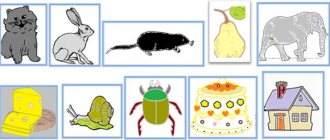Summary of a lesson on speech development in the middle group “Sound culture of speech: sounds s, s”
Summary of educational activities for speech development in the middle group “Sound culture of speech: sounds s, s”
Description: I bring to your attention a summary of direct educational activities on speech development for children from 4 to 5 years old “Sound culture of speech: sounds s, s”. Goal: Explain the articulation of sound [s]. Objectives: - Practice correct, distinct pronunciation of the sound [s] in words and phrasal speech. — Develop phonemic hearing; develop speech breathing. — Cultivate curiosity and interest in knowledge. Methodological techniques: teacher's story, demonstration, explanation, artistic expression, surprise moment. Materials and equipment: Dog toy, narrow strips of paper according to the number of children.
Progress of GCD
1. Organizational moment. All the children gathered in a circle, I am your friend, and you are my friend. Let's hold hands tightly and smile at each other. Educator: Guys, someone came to our lesson today. And who it is, you will find out when you guess the riddle: He waves his tail joyfully, When the owner comes into the house. Her destiny is this: to keep the house from strangers. (Dog) Children's answers. 2. Main part. Educator: That's right, this is a dog (Shows a toy dog). Guys, the Dog can’t say the sound [s]. Let's teach her. Let's sit on the chairs and invite the dog to sit on the chair. Children: Sit down, little dog, on the chair. Educator: Let's play with our tongue. Game exercise “Funny Tongue” - The tongue lives and lives in its house, and the tongue’s house is its mouth. The house opens and closes. (The teacher slowly closes and opens his teeth. Lips in a smiling position)
.
The tongue either peeks out from the house or hides. (The teacher invites the children to let the tongue out for a walk, and then return it to the house)
.
Game exercise “Water Song” The tongue loves to sing different songs. One day he sang: “E-and-and.” Would you like to sing along with me? (Children's answers)
.
Educator: Then help me: “E-and-and-and.” We sing a song quietly. Well done. Educator: Guys, I know one more song. Here the water poured out of the tap: “Ssssss.” - Tongue, please learn my song too. “Good,” the tongue agreed and sang: “S-s-ss.” (Pronounced abruptly.)
Let's sing “Song of Water” together.
To make the song sound good, you need to press the tip of your tongue to your lower teeth. Children: “S-s-s-s” Educator: Close the tongue-mouth house, rest. Now press the tip of your tongue against your lower teeth again and softly sing: “Ssss.” Like this. Let's listen to how Varya, (Seryozha, Arina, Egor)
.
Now let’s sing a song all together (everyone sings the water song “S-s-s-s”)
.
The teacher suggests singing the water song at different volumes. Educator: Water flows in a small stream and sings a quiet song. Now the water began to gurgle louder. Quiet. Very quiet. The tap was closed. Physical education lesson We are autumn leaves sitting on branches (sit down)
.
The wind blew and they flew. We flew, we flew (running on tiptoes in a circle)
, and quietly sat down on the ground
(sit down)
.
The wind came again, And the leaves all picked up (running on tiptoes in a circle)
, They spun, flew, And sat quietly on the ground
(sit on chairs)
.
The teacher asks the children to sing the water song slowly and abruptly. Educator: If you sing “Song of Water” slowly and abruptly (like this: s...s...s...s), then it seems that the wind is dancing around your lips. Do you want to make sure of this? (Children's answers)
.
Educator: Then make the same fence, like me. Bring your palm to your lips, but don’t press them, and let the breeze dance. Look: now I will sing the song of water, and the piece of paper that I hold in front of my mouth will begin to move. What did you see? (The paper moved)
. Take the same strip of paper
(narrow strips of paper lie on the table)
and sing the water song.
sayings And now, guys, put the paper strip aside and listen: The tongue began to compose other songs similar to the water song. At first he sang: “Sa-sa -sa". What did the Tongue sing? (Children repeat)
. Then the Tongue sang: "Xia-xia-xya, axis-axis-axis"
(Children repeat)
. And now let's repeat after the Tongue the pure saying: Su-su-su - berries in the forest. Us-us-us - there are a lot of beads on the tree. Sa-sa-sa - there is a fox under the bush. As-as-as - the light in the fire has gone out.
Educator: What a great fellow you are, children. Today you helped the dog learn the sound [s]. She says "Thank you" to you. 3. Bottom line. Who came to visit us? What did we do in class today? What did you like and remember most about the lesson?
We recommend watching:
Summary of a lesson on speech development in the middle group on the topic: “Ukraine is my native land” Notes on the development of speech in the middle group Notes on the lexical topic “Transport” for children 4-5 years old with severe speech impairments Notes on the development of speech in the middle group middle group
Similar articles:
Summary of a lesson on speech development in the middle group on the topic “Our Street”
What to do if a child does not speak the sound Z and Zь
Option 1. If the child does not say all the whistling sounds (С, Сь, З, Зь, Ц
), then first we work with the sound C and its soft version Сь. And only after that + we call out the sound Z and reinforce its correct pronunciation. If a child has mastered the sound C well, and the sounds C and Сь are perfectly automated in words, phrases, poems, and dialogues, then producing the sound Z will not cause difficulties.
Option 2.
If a child speaks the sounds S and S very well, but pronounces the sound Z incorrectly , then usually there are no problems with pronouncing the sound Z and consolidating its correct pronunciation.
The baby quickly begins to pronounce this sound correctly simply by imitation. So, we begin to work on the sound Z when the child already speaks the sounds S and Сь perfectly. Children are usually ready for this at the age of four.
How to evoke the sound Z by imitation?
In the absence of the sounds З and Зь or their replacement with other sounds, you can first try to evoke the sound З by imitation.
Ask your child to sing the mosquito song zzzzzz.
- Show what position the lips have (smile), tongue (wide with a groove in the middle).
- Pronounce the sound Z – “mosquito song” – slowly.
- Ask your child to repeat it.
Play mosquitoes with your child - reinforce the sound “z”. Remind your child how in the summer mosquitoes in the forest sing their song: “zzzz” and bother us. Let the child be a mosquito in the forest and sing the mosquito song “zzz”, and you will run away from him into the house and hide.
When playing with a group of children, one half of the children “walks in the forest”, the other pretends to be mosquitoes and rings “zzz”. Then the children change roles.
After the children ring like mosquitoes, show them the difference in the articulation of the sound C and the sound Z. Sit in front of the mirror. And compare the sounds s (“pump song”) and the sound z (“mosquito song”). Draw the children’s attention to the fact that the sound C—“pump song”—sounds quietly, and the mosquito song sounds loud—zzzz—and a voice can be heard. The mouth is the home of the voice. And when the voice loudly sings the song of a mosquito, even the walls of the house tremble. And you can feel it.
Demonstrate these unusual sensations to your child. First, place the child’s hand on your neck when you say the sound Z. Let him feel the vibration as you pronounce the sound “z.” Then ask your child to put one hand on the back of your neck, and the other hand on his neck, and sing the mosquito song “zzzzz” with him. Children usually really like this task, new sensations that are unexpected for them.
Compare with the sound C - “pump song”. Pull the ssss sound. Trembling - no vibration! Tell your child that the sound C is a dull, quiet sound, our voice sleeps. And the sound Z is loud, ringing, the voice loudly sings the song zzzzz.
Very often this exercise and explanation is enough for the sound Z to appear in the child’s speech.
What difficulties may arise when working with the sounds З and Зь? Useful tips.
Advice one. If a child cannot make the sound Z, then the reason may be insufficient development of the organs of the articulatory apparatus.
Articulation exercises for whistling sounds will help cope with this problem. You will find a detailed complex of articulation gymnastics in step-by-step descriptions and videos in the article “How to teach a child to pronounce the sounds C and Сь.”
Tip two. If a child cannot make a groove in the middle of his tongue when pronouncing the sound Z, then most likely his tongue muscles are underdeveloped. Exercises will help us:
- Ask your child to smile widely (stretch their lips) and hold their lips in this position. If your lips are stretched, you need to stick your outstretched tongue out and blow on its tip. You will get a groove in the middle of the tongue. The exercise is carried out in front of a mirror.
- If the groove does not work, then ask the child to stick the wide tip of his tongue out. Place the edge of a teaspoon in the middle of your tongue. Having made a small depression in it, ask the child to blow air along this groove. You can blow on cotton wool or a thin strip of paper, then the result of the exercise will be clearly visible. As soon as the child can easily do this exercise, you can ask him to move his tongue behind his lower teeth (maintaining the position of his lips). The result is the sound S. When you add a voice to it, you get the sound Z.
- The exercise described above can be done with a glass vial (a glass jar or bottle from a pharmacy). Teach your child to whistle into a bubble so that the tip of the tongue moves slightly outward or touches the edges of the bubble. Air flows along the groove in the middle of the tongue and the result is a whistle. First, try whistling yourself in front of a mirror, and then show the exercise to your child. If the groove in the middle of the tongue does not work out for him, place a thin round stick along the tongue.
Tip three. If a child sticks his tongue out between his lips when pronouncing the sound Z
(therefore the sound is distorted), then do this exercise. Ask your child to stretch his lips into a smile and close his teeth tightly. And whistle like a pump ssssss. And then sing like a mosquito zzzzzzz. With clenched teeth, the tongue will automatically rest against the lower teeth, and the correct sound will be produced.
You will learn more about the methods of producing sounds S and Z from a video by a speech therapist about producing whistling sounds.
The sound Z appeared. Now we are faced with an important task - to automate this sound in the child’s speech.
The sequence of exercises to consolidate the correct pronunciation of the sound Z:
- 1. exercises with isolated sound,
- 2. sound in syllables,
- 3. sound in words
- 4. sound in phrases, poems, stories, dialogues, tongue twisters.
First we work with the sound Z, and then with its soft version - the sound Зь. Games, tongue twisters, nursery rhymes, poems, and pictures are selected for each stage.
Stories and fairy tales with the sound Z for classes on ZKR with preschool children.
Bunnies (Lithuanian fairy tale)
Bunnies were born to a hare. The father looked at his children and said to them: “I have a mustache, and you already have a mustache!” So, that means, get your own food. Since then, the little hares, as soon as they are born, live alone, without parents, in a dark forest: they have neither a nest nor a hole. But everyone with a mustache, everyone from the first days can get their own food.
Boy and goats.
Once upon a time there was a boy, and he had three goats. During the day the goats galloped and jumped on the rocks, and by night the boy drove them home. One evening the boy began to drive them home, and the goats ran into the cabbage field, and there was no way to get them out of there. The boy sat down on a hillock and began to cry. A hare walked past. - Why are you crying? – the hare asked the boy. “I’m crying because I can’t drive the goats out of the field,” the boy answered. “I’ll drive them out,” said the hare. The hare began to drive out, but the goats did not come. The hare sat down and also cried. A fox walked past. - Why are you crying? – the fox asked the hare. “I’m crying because the boy is crying,” says the hare, “And the boy is crying because he can’t drive the goats out of the field.” “Calm down, I’ll drive them out,” said the fox. She began to drive out, but the goats would not come. The fox sat down here and also began to cry. And so the wolf drove him away, but he didn’t drive him out either. A bee was flying here. He sees that they are all sitting and crying, and says: “I’ll kick them out.” Then all the animals and the boy stopped crying and began to laugh at the bee. How will she drive out the goats when they all couldn’t cope! But the bee flew to the cabbage field, sat on the goat, and began to buzz. - Zhzhzhzhzh! Zhzhzhzhzh! Zhzhzhzh! How the goats will start running! And they ran home from the field.
Monkey Ruza. The author of the story is A.I. Maksakov. From the book “Development of correct speech of a child in the family” (Publishing house Mozaika - Synthesis, 2011).
“Dad brought Zoya a monkey from Africa. Zoya named the monkey Ruza. Ruza knew how to jump funny and imitate Zoya's friends. Zoya taught Ruza to answer the doorbell. In winter, Ruza fell ill. Zoya took Ruza to the doctor, gave her various herbs, and fed her bananas. Thanks to Zoya’s care, Ruza recovered.”
Ask your child questions about the content of the story. Ask them to find words with the sound Z in the story and make up their own sentences with them.
The story "Girlfriends". Author – M.F. Fomicheva. From the book “Educating Children to Pronounce Correctly.”
“Zoya, Lisa and Aza are friends. Friends gathered at Zoya's. Zoya, Lisa and Aza play together. The Muse doll is put to bed. They go for a walk with a funny bunny. Mom called Lisa home. Azu was also called. Zoya was left alone. Zoya's teeth hurt. Zoya tied her teeth and sits. Lisa found out about this. Zoe brought a mosaic. Aza also found out. I brought Zoya some forget-me-nots. Zoya put forget-me-nots in a vase. Lisa, Zoya and Aza began to play mosaic. They made a beautiful mosaic pattern! Then they asked riddles:
As soon as she got down to business, she sawed and sang. She ate, ate oak, oak, broke a tooth, a tooth. (Saw)
Kuzma is knotty and cannot be untied. ( Chain)
He himself doesn’t know the days, but he points them out to others. (Calendar)
The friends had fun for a long time. Zoya forgot about her bad teeth.”
Ask your child questions about the content of the story. Make sure that he pronounces the sound Z correctly in his answers.
An outdoor game to reinforce the correct pronunciation of the sound Z “Find out by voice.”
Authors: E.I. Radina, V.I. Rozhdestvenskaya.
This game develops children's auditory attention. A circle is drawn on the ground. Children run around the playground. At the adult’s signal, “One, two, three – run in a circle!” they gather in a circle.
The driver is selected. He is blindfolded. He turns his back to the children.
All the children say:
“We frolicked a little, everyone settled down in their places. Guess the riddle, Find out who called you!”
The adult gestures to one of the children, who says: “I’m calling you!” The child driver guesses who called him: “Vova called me? Katya called me?”
If the child guessed who called him, then he changes places with this child. And the other child becomes the driver.
If the child did not guess who called him, then he guesses again in the next game.
In the game you can change your voice, speak in a squeaky high voice or a thick bass voice. It's always interesting and unexpected in this game how players will change their voice.



